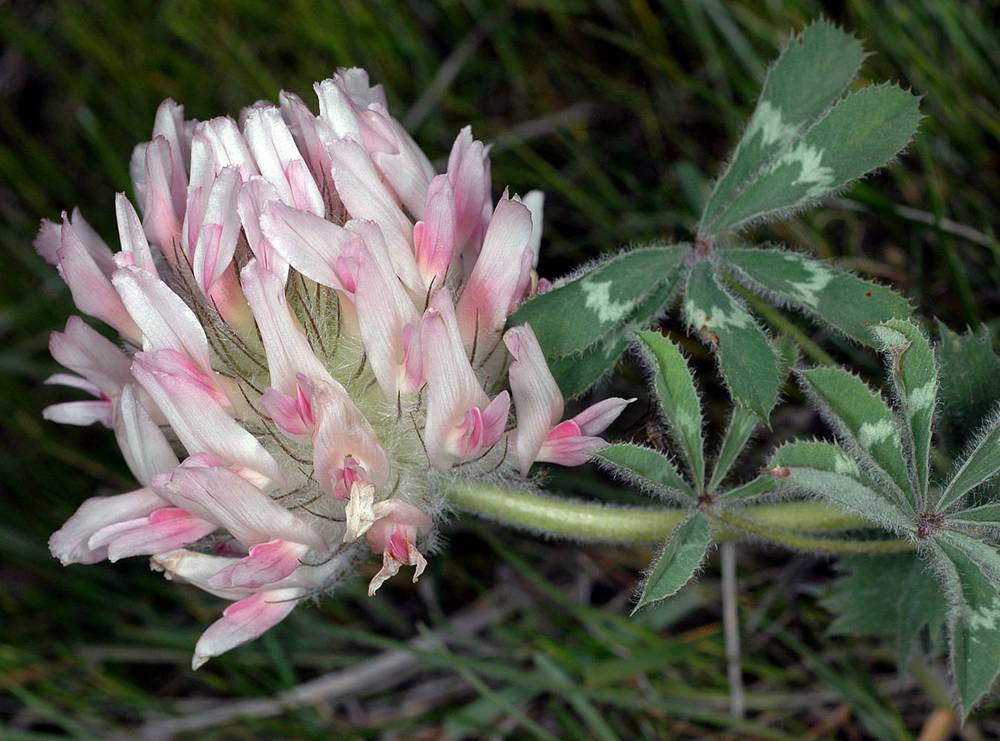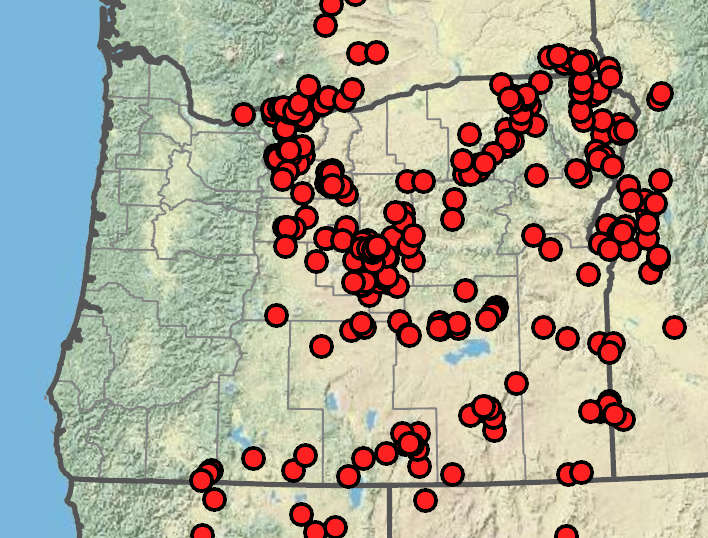Trifolium macrocephalum
Trifolium variegatum
big-headed clover, largehead clover
white-tip clover
palmate;
leaflets (5)7–9, broadly to narrowly obovate, often folded, 10–27 × 4–11 mm, bases cuneate;
margins serrulate or irregularly lobed;
veins thickened, especially distally;
tips rounded or truncate, apiculate;
surfaces abaxially villous, adaxially sparsely villous to glabrate;
petioles 10–140 mm;
petiolules 0.9–1.2 mm;
stipules ovate, obovate, or oblong, 10–30 mm;
margins entire.
palmate, dimorphic, with gradual or abrupt transition between proximal and distal leaves;
leaflets 3, obovate-obcordate to elliptic-obovate, 2.9–11.4 × 1.9–5 mm, bases cuneate;
margins serrate;
veins fine;
tips emarginate-mucronate or rounded-mucronate;
surfaces glabrous;
petioles 1–95 mm;
petiolules 0.1–0.8 mm;
stipules broadly triangular to ovate, recurved or not, 2–10 mm;
margins laciniate;
tips acute.
terminal, 20–32-flowered, globose or ovoid-ellipsoidal, 25–80 × 30–70 mm;
involucres absent;
bracteoles broadly ovate, membranous; ? 0.5 mm, truncate.
axillary, 1–25-flowered, racemose-umbellate, 4–12 × 1–10 mm, not elongate in fruit;
involucres flat, laciniate, 3–12 mm, 2–7-lobed;
lobes toothed; longest tooth 0.6–3 mm;
bracteoles absent.
20–80 mm.
4–6 mm.
erect, 1–1.5 mm.
straight, 0.1–0.5 mm.
20–30 mm;
calyces campanulate, 10–22 mm, villous;
veins 10–15;
tubes 2.5–4 mm;
lobes subulate, subequal, 2–4 × tube length, plumose;
orifices open;
corollas 20–28 mm, white; creamy white, or pinkish;
banners ovate or oblong, 20–28 × 10–13 mm;
tips rounded or slightly emarginate;
keel petals deep pink.
3–10 mm;
calyces tubular, 2.1–6.8 mm, glabrous;
veins 10–20;
tubes 1.9–2.4 mm;
lobes awl-like to shouldered, subequal;
tips purple or stramineus;
orifices open;
corollas 3–10 mm, included in or exserted beyond tips of calyces 0.1–5.7 mm, purple, usually white-tipped;
banners obovate, 3.2–9.7 × 0.6–2.6 mm;
tips emarginate;
keel petals not beaked.
longitudinally dehiscent; ovoid, 4–5 mm; ? calyces.
laterally compressed, ellipsoid, 2.2–4 mm; < calyces, chartaceous. Seeds 1–2, globular to mitten-shaped, 1.1–1.6 mm; blackish brown; dark-speckled or not.
1–2; mitten-shaped to ellipsoid, 2.5–3 mm, yellow or reddish; smooth.
=32, 48.
=16.
Trifolium macrocephalum
Trifolium variegatum
Rocky places, hard, compacted clay gumbo, lava beds, sage-covered slopes. Flowering Apr–Jul. 0–2200 m. BR, BW, Col, ECas, Lava, Owy. CA, ID, NV, WA. Native.
Trifolium macrocephalum has the largest inflorescences of any species in the genus. The name T. megacephalum is an illegitimate replacement name for Lupinaster macrocephalum.
Wet places, meadows. Flowering Apr–Aug. 0–2200 m. All ecoregions except Lava. CA, ID, NV, WA; north to AK, east to WY, south to Mexico. Native.
Trifolium variegatum is a widespread and morphologically variable species. Because of this variability, T. variegatum and the related species T. appendiculatum and T. polyodon were lumped into seven “phases” by Isely (1998), who described these as “ecotypic groups,” some of which might deserve varietal or specific rank. A recent revision of T. variegatum (Foster 2015) resulted in recognition of two species, a widespread T. variegatum (including T. melananthum, T. geminiflorum, and T. subsalinum), and T. appendiculatum, which is restricted to California, except for reports from Grants Pass (Josephine County) from 1910, and Sutherlin (Douglas County) from 1932. Cooper (1957) considered this species a good choice for cultivation in wet areas for grazing and hay production.
Michael Vincent
Michael Vincent
- Local floras:
BC,
CA,
OR,
WA
- Local Web sites:
CalFlora,
CalPhotos,
Flora NW,
PNW Herbaria,
Turner Photog.
WildflowerSearch
iNaturalist (observations)
USDA Plants Database
- LBJ Wildflower Center
- SEINet
- Plants of the World Online
- Encyclopedia of Life
- Wikipedia
- Google Image Search





